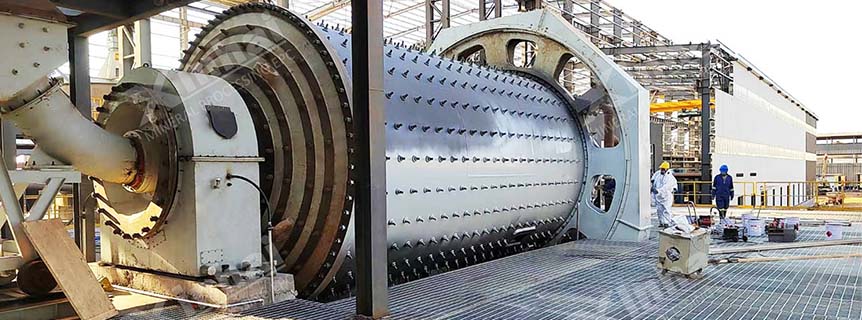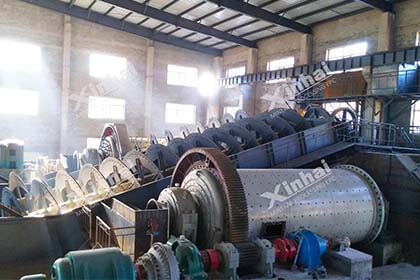Rod Mill Maintenance: Tips for Longevity and Performance
 Laura
Laura
 Oct 30, 2024
Oct 30, 2024
 519
519
If you want to know more details about equipment, solutions, etc, please click the button below for free consultation, or leave your requirements!

( Rod mill maintenance tips )
Rod mills are essential pieces of equipment in various industries, particularly in mining and mineral processing. Their primary function is to grind materials into fine particles, making them ideal for the production of various minerals and materials. However, like all machinery, rod mills require regular maintenance to ensure optimal performance and longevity. In this blog post, we will explore various tips and best practices for maintaining rod mills, addressing common issues, and ultimately enhancing their lifespan and efficiency.
01Understanding the Importance of Rod Mill Maintenance
BackBefore diving into maintenance tips, it's crucial to understand why maintenance is essential for rod mills. Proper maintenance not only extends the life of the equipment but also optimizes its performance, resulting in increased productivity and reduced operational costs. Here are a few reasons why rod mill maintenance should be a priority:
1. Preventing Downtime
Regular maintenance helps identify potential issues before they escalate into significant problems that could lead to unplanned downtime. This is crucial in industries where time is money.
2. Enhancing Efficiency
Well-maintained equipment operates more efficiently, leading to better energy consumption and reduced operational costs.
3. Improving Product Quality
Consistent maintenance ensures that the grinding process is uniform and effective, resulting in higher-quality end products.
4. Safety
Regular maintenance helps identify and rectify safety hazards, protecting workers and minimizing the risk of accidents.
5. Cost Savings
Proactive maintenance can save money in the long run by preventing costly repairs and replacements.
02Key Components of a Rod Mill
BackTo effectively maintain a rod mill, it is essential to understand its key components. A typical rod mill includes the following parts:
- **Drum**: The cylindrical shell where the grinding action occurs.
- **Rod Load**: The steel rods that are charged into the mill and used for grinding.
- **Drive Mechanism**: The motor and gearbox that provide the necessary power to rotate the drum.
- **Feeding and Discharging Mechanism**: Systems for introducing raw materials and removing the finished product.
- **Liners**: Protective materials that line the inside of the drum to prevent wear and tear.
03Maintenance Tips for Rod Mills
Back1. Regular Inspection
Regular inspections are the foundation of effective rod mill maintenance. Schedule routine checks to identify any wear and tear, misalignments, or other issues. Key areas to inspect include:
- **Drum and Liner Condition**: Check for signs of wear, cracks, or corrosion. Replace liners when they become excessively worn to maintain optimal grinding efficiency.
- **Rod Load Inspection**: Ensure that the rods are in good condition and not excessively worn or broken. Regularly monitor the rod charge to maintain the appropriate level for effective grinding.
- **Drive Mechanism**: Inspect the motor, gearbox, and belts for any signs of wear, overheating, or misalignment. Ensure that all connections are secure.
2. Lubrication
Proper lubrication is vital for the smooth operation of rod mills. It minimizes friction, reduces wear, and prevents overheating. Follow these lubrication tips:
- **Use the Right Lubricants**: Always use the lubricants recommended by the manufacturer. Different components may require different types of lubricants.
- **Regular Lubrication Schedule**: Establish a lubrication schedule based on the manufacturer's recommendations and operational conditions. Under-lubrication can lead to increased wear, while over-lubrication can attract contaminants.
- **Lubrication Points**: Ensure that all lubrication points are easily accessible for maintenance. Regularly check and refill lubrication reservoirs as needed.
3. Maintain Proper Rod Charge
The rod charge is critical to the rod mill's performance. An improper rod charge can lead to inefficient grinding and increased wear on the rods and liners. Here are some tips for maintaining the right rod charge:
- **Monitor Rod Length and Diameter**: Ensure that the rods used in the mill are of the correct length and diameter. Using rods that are too short or too thin can result in poor grinding efficiency.
- **Rod Replacement Schedule**: Establish a schedule for replacing worn rods. Regularly assess the condition of the rods and replace them when they reach the end of their useful life.
- **Avoid Overloading**: Do not overload the mill with too many rods or excessive material, as this can lead to increased wear and potential damage to the equipment.
4. Optimize Operating Conditions
Operating conditions play a significant role in the performance and longevity of rod mills. Consider the following tips to optimize operating conditions:
- **Feed Rate**: Maintain a consistent feed rate to ensure a uniform grinding process. Sudden changes in feed rate can lead to fluctuations in mill performance.
- **Water Addition**: If your process requires water, monitor the water addition to the mill. Too much or too little water can affect the grinding efficiency and product quality.
- **Operating Speed**: Ensure that the mill is operating at the manufacturer's recommended speed. Operating too fast can lead to excessive wear, while operating too slowly can reduce grinding efficiency.
5. Monitor Vibration and Noise Levels
Excessive vibration and noise can be indicators of underlying issues with the rod mill. Regularly monitor these levels and take corrective action if necessary:
- **Vibration Analysis**: Use vibration analysis tools to detect any irregularities in the mill's operation. Excessive vibration can indicate misalignment, worn bearings, or other mechanical issues.
- **Noise Monitoring**: Pay attention to changes in noise levels during operation. Unusual noises may indicate problems with the drive mechanism, bearings, or other components.
6. Clean the Mill Regularly
Cleaning the rod mill is an often-overlooked aspect of maintenance. Regular cleaning helps prevent the buildup of debris and contaminants, which can affect performance:
- **Remove Material Build-up**: Periodically check for and remove any material buildup inside the mill that could interfere with the grinding process.
- **Cleaning Agents**: Use appropriate cleaning agents that will not damage the mill's components. Avoid harsh chemicals that could corrode or wear down surfaces.
7. Train Operators
Well-trained operators play a crucial role in the maintenance and performance of rod mills. Ensure that your operators are adequately trained in the following areas:
- **Operating Procedures**: Provide training on proper operating procedures to minimize the risk of accidents and equipment damage.
- **Maintenance Practices**: Educate operators on basic maintenance practices, including routine inspections and lubrication.
- **Troubleshooting**: Train operators to recognize signs of potential problems and take corrective action before issues escalate.
8. Document Maintenance Activities
Keeping accurate records of maintenance activities is essential for effective rod mill management. Consider the following practices:
- **Maintenance Logs**: Maintain detailed logs of all maintenance activities, including inspections, lubrication, and repairs. This documentation helps track the history of the mill and identify recurring issues.
- **Performance Metrics**: Monitor and record performance metrics such as throughput, product size, and energy consumption. Analyzing these metrics can help identify trends and areas for improvement.
- **Review and Adjust**: Regularly review maintenance logs and performance metrics to identify patterns and adjust maintenance practices as needed.
9. Collaborate with Manufacturers and Experts
When it comes to rod mill maintenance, collaboration with manufacturers and industry experts can provide valuable insights. Consider the following approaches:
- **Manufacturer Support**: Consult with the rod mill manufacturer for specific maintenance recommendations and troubleshooting advice.
- **Industry Best Practices**: Stay informed about industry best practices and emerging technologies that can enhance rod mill performance.
- **Training Programs**: Participate in training programs or workshops offered by manufacturers or industry organizations to stay updated on the latest maintenance techniques.
04Common Issues and Solutions
BackDespite the best maintenance practices, rod mills may still encounter common issues. Here are some typical problems and their solutions:
1. Excessive Wear
**Cause**: Excessive wear can result from improper rod charge, incorrect operating conditions, or inadequate lubrication.
**Solution**: Regularly inspect rods and liners, maintain proper rod charge, and ensure consistent lubrication. Consider adjusting operating parameters to reduce wear.
2. Poor Grinding Efficiency
**Cause**: Poor grinding efficiency can result from improper feed rate, incorrect rod length, or insufficient water addition.
**Solution**: Monitor and adjust feed rates, ensure rods are of the correct size, and optimize water addition for the grinding process.
3. Overheating
**Cause**: Overheating may occur due to inadequate lubrication, excessive load, or improper cooling.
**Solution**: Ensure proper lubrication, avoid overloading the mill, and consider implementing cooling systems if necessary.
4. Vibration Issues
**Cause**: Excessive vibration can result from misalignment, worn bearings, or unbalanced loads.
**Solution**: Regularly check for misalignments, inspect bearings, and balance loads within the mill.
05Conclusion
BackIn conclusion, effective rod mill maintenance is essential for ensuring optimal performance and longevity. By following the tips outlined in this blog post—such as regular inspections, proper lubrication, maintaining the right rod charge, optimizing operating conditions, and training operators—businesses can significantly enhance the performance and lifespan of their rod mills. Additionally, addressing common issues proactively will further contribute to the overall efficiency and productivity of the equipment.
Investing in proper maintenance practices not only extends the life of rod mills but also leads to improved product quality, reduced operational costs, and a safer working environment. By prioritizing maintenance, industries can maximize the value of their rod mills and achieve long-term success in their operations.
Contact us and learn more about Rod Mills.
 +86 18716000713
+86 18716000713 xlyin@xinhaimining.net
xlyin@xinhaimining.net




 Message
Message Chat Now
Chat Now


















